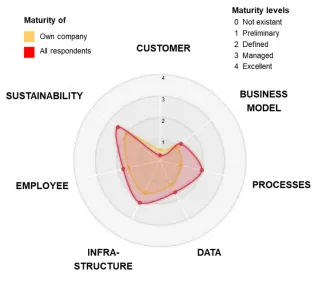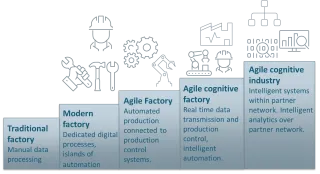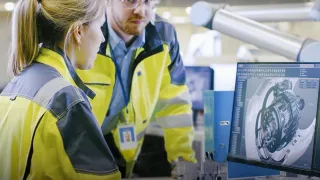"Competitive edge for Manufacturing Industry in one-off production, due to extreme flexible and efficient manufacturing networks."
Products and production contain ever more often also data-based services. The digitalization of industry with sensors and advances in communication technology has enabled the exploitation of increasingly growing amounts of data across partner networks. This requires the systematic collection, storage, transfer, processing, combining and analysis of data, from both the own company and the partner network. The existing data in the current product, production control and enterprise resource planning systems forms the basis for development. When discussing about the future of the manufacturing industry, terms like agility and cognitivity come to mind, especially regarding co-working of humans and technology. What are we talking about then?
Holistic framework covers business, technology and responsibility viewpoints
Demands for agility and cognitivity challenge traditional actors in manufacturing industry networks. New enabling technologies are paving the way for increased flexibility and agility in dynamic manufacturing networks with more intelligent processes. These technologies include e.g. Industrial Internet, robotics, artificial intelligence (AI), 5G and edge computing. They aim for better customer orientation and productivity but lead also to new ways of working, processes and business opportunities. However, technology alone does not lead to success. Developing and reforming business models is a key factor when responding to future challenges. An agile company observes not only customers and their behaviour, but also future trends together with the partners in its network.
Responsibility will also become increasingly important in companies’ operations. As environmental awareness increases, the significance of minimization of resource usage and environmental impacts is growing. The optimal interaction between humans and technology is further emphasized when taking AI and robotics into use. In addition, the work content and the roles of employees in industry will also change.
These three sectors (technology, business and responsibility) form the foundation of our manufacturing industry maturity model. By looking at their activities through these viewpoints, manufacturing industry companies can map their capabilities and identify development targets.
Looking at the industry's agile and sustainable future, the gaze is now shifting past the ongoing development trend, Industry 4.0, and outlining the winning qualities that will follow. There is a number of large-scale projects in Europe that aim to develop the manufacturing industry. VTT has also been actively involved in projects and initiatives that explore and develop solutions to support the manufacturing industry's competitiveness. VTT has also published a white paper titled Beyond IoT business discussing future opportunities and development paths in manufacturing industries, and A review of digitalisation in the Finnish manufacturing SME companies. The work done in ongoing and past projects provides a starting point for developing a maturity model for a future-oriented manufacturing industry - and enables the creation of more precise pathways for progress.
Self-assessment tool for manufacturing industry
The maturity model developed serves especially those manufacturing companies which focus on customer-specific tailoring, or even one-off production. The related web tool helps companies to recognize their maturity level. It contains the most essential viewpoints and dimensions of agile cognitive industry. For each dimension there is a question and five response alternatives at different maturity levels to choose from. Based on the answers, the public web tool calculates the average for each dimension and displays the situation of own and other respondents as a graph. If control group information is needed e.g. based on branch or size turnover and/or headcount, or if you want to find out how to proceed, please contact VTT. The test takes about 15-20 minutes.

Maturity levels
At the first level there is a traditional factory where data processing is still completely manual except for office programs. Production uses traditional machines and equipment that do not produce digital data as separate factors of production. Workers' work consists mainly of physical repetitive tasks. The company sells mainly capacity/ subcontracting, not own products.
The modern factory already has separate digital processes, but the combination of data is done manually. The factory has automation islands and robots. Additional income is gained from consulting and customizing the use of products. In the modern factory digitalization is siloed, while there are some digital interfaces between employees and machines, but not between systems. The company has partially automated production but with limited flexibility. Work is a combination of physical and knowledge-based tasks. The company sells products and supplementary services such as product design and/or technical support.
The agile factory features automated production, such as flexible manufacturing systems (FMS cells). The company gathers up-to-date information both from the production process and from product life cycle, and integration of it takes place mainly automatically. Automated production and/or flexible robotic systems are reconfigurable and connected to production control systems. Intelligent systems and/or robots allow employees to focus on more cognitive tasks, e.g. planning and monitoring, as repetitive tasks have been automated. The company offers product-related supplementary services such as predictive maintenance and updates.
In an agile cognitive factory, the information moves in real-time. Agile and efficient production is based on real-time production control of the supply chain, which takes care of rerouting, retiming and replanning when needed. Intelligent automation cooperates with workers in performing complex tasks. The real-time control system has remote interfaces. The company can act as performance partner and bears (at least partially) the responsibility for the actual performance of the product.
Agile cognitive industry is a level where products and services are manufactured and produced in agile and tailored (even one-off) way based on demand. Procurement of materials is forecasted including the whole supply chain and manufacturing is planned based on predicted demand. Customers can plan and order personalised products with possible services in cooperation with the partner network. They can be upgraded when in use. Agile and efficient production is enabled by intelligent AI based systems that interact in the partner network. Intelligent analytics verifies and prepares the data in real-time before they are used in the decision-making in the partner network. Complex processes are performed without regular human intervention in the partner network.
Test the maturity of your company
With the maturity self-assessment tool developed, the company can determine its own maturity level in addition to strengths and weaknesses with regard to seven dimensions. The questions and answer alternatives have been formulated to make it possible for a company representative to do it independently within 15-20 minutes: https://manumaturity.vtt.fi/.
We welcome all feedback about the tool and will be happy to discuss potential development paths with companies.
VTT has also previously released web-based self-assessment maturity tools for both digitalisation and artificial intelligence. Just click the links and have a go!







